Prisms has many types depends on the base. There are many daily things in prisms such as aquarium, tent, tissue box, cupboard, etc..
Table of Contents
Definition of Prisms
Prisms is three-dimensional shape that is bordered by two bases and lateral planes.
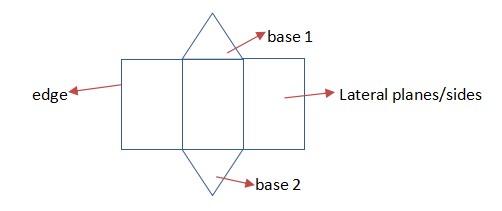
Number of lateral planes is same with number of edges of the base. Consequently, type of prisms depends on the base.

Properties of Prisms
There are some properties of prisms:
- It has two bases that are congruent and parallel.
- The bases are linked by lateral side/plane.
- Number of lateral sides depends on type of polygon as the base.
- Height of prism is distance between two bases.
- The vertices of prism are twice of vertices of base.
- The edges of prism are three times of the edges of base.
Types of Prisms
There are some types of prism depends on the shape of the base.
- Irregular prism
Irregular prism means prism that has irregular shape as the base. Besides that, irregular prism has irregular cross section in shape.
- Regular prism
Regular prism means prisms that has polygon as the base. In other words, regular prism has regular shape (same measure in length and the angles) in the cross section. It is like triangular prisms (triangle base), square prisms (square base), pentagonal prisms (pentagon base), etc.. It is easier to determine the surface area and volume than the irregular ones.
Surface Area of Prisms
Surface area of prims means total area that is covered the prism. Because of in general concept prism consist of two bases and some faces, then
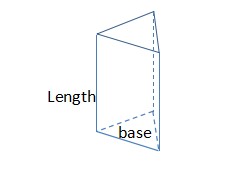
Surface area = 2 x area of base + base perimeter x length
Volume of Prisms
Prisms has some type depends on the base. Volume of prism means capacity in the prism. The volume of prisms in general form is
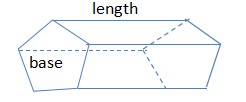
Volume of prism = Area of base x length
Note: base is not always in bottom side. Base is parallel planes.
Right and Oblique Prisms
There are two type of prism depends on the prism’s position (slope).
- Right prism
Right prism is a prism that has aligned edges perfectly.
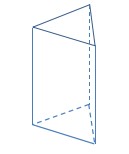
- Oblique prism
Oblique prism is a prism that the edges are not align. The length of oblique prism is distance between base and the center of the top side.
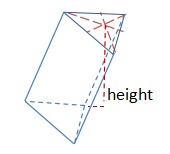
Examples
1. Determine the surface area and the volume if there is a hexagonal prism that has base area 24√3, base perimeter 24 and the height is 8.
Base area = 24√3
Base perimeter = 24
Height = 8
- Surface area = 2 x base area + base perimeter x height
= 2 x 24√3 + 24 x 8
= 48√3 + 192
- Volume = base area x height
= 24√3 x 8
= 192√3
2. Determine the volume
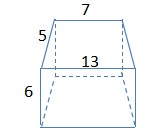
The base is trapezoid, then the height of trapezoid can be calculated using Pythagorean theorem.

- base area = {(a+b)/2} x height of trapezoid
= {(7+13)/2} x 4
= 10 x 4
= 40
- Volume = base area x height of prism
= 40 x 6
= 240
3. Determine the height of triangular prism if the volume is 84 cm3 and the base is triangle with 3, 4, and 5 cm as the sides.
Volume = perimeter of the base x height
84 = (3+4+5) x h
84 = 12 x h
h = 7 cm.
